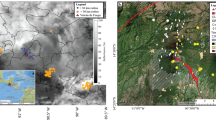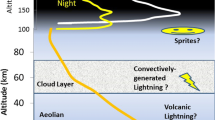Abstract
Lightning commonly occurs in the eruption columns produced by explosive volcanic eruptions. There are several different kinds of lightning detection instruments that could be employed to help monitor volcanoes, each with their own advantages and disadvantages. Very low frequency (VLF) instruments have the ability to detect lightning at long ranges but tend to have low sensitivity due to network geometry and typically can provide only the time and 2-D location of a cloud-to-ground return stroke or similar high-amplitude pulse produced by an intracloud discharge. Low frequency (LF) and medium frequency (MF) instruments typically have more sensitivity than a VLF network but can only be used for detection on a regional scale. Very high frequency (VHF) lightning mapping instruments also provide only regional coverage but detect all lightning within their range. During the 2009 eruption of Redoubt Volcano, Alaska, USA, each of these types of instruments detected lightning from Redoubt’s ash plume. The VHF system consistently detected lightning before the other two during each distinct explosive event and also detected more lightning than the others, by one or two orders of magnitude. Lightning observations could be used to confirm, and in some cases, detect explosive volcanic activity. The rapid response provided by lightning monitoring is a valuable tool for fast identification of potentially hazardous ash clouds.









Similar content being viewed by others
References
Abarca, S. F., K. L. Corbosiero, and T. J. Galarneau Jr. (2010) An evaluation of the Worldwide Lightning Location Network (WWLLN) using the National Lightning Detection Network (NLDN) as ground truth., J. Geophys. Res. 115 (D18206)
Aizawa, K., A. Yokoo, W. Kanda, Y. Ogawa, and M. Iguchi (2010) Magnetotelluric pulses generated by volcanic lightning at Sakurajima volcano, Japan. Geophys. Res. Lett. 37 (L17301)
Arason, P., A. Bennett, and L. E. Burgin (2011), Charge mechanisms of volcanic lightning revealed during the 2010 eruption of Eyjafjallajökull. J. Geophys. Res. 116, doi: 10.1029/2011JB008651
Behnke SA, Thomas RJ, Krehbiel PR, McNutt SR (2012) Spectacular lightning revealed in 2009 Mount Redoubt eruption, Eos Trans. AGU 93(20):193
Behnke SA, Thomas RJ, McNutt SR, Schneider DJ, Krehbiel PR, Rison W, Edens HE (2013) Observations of volcanic lightning during the 2009 eruption of redoubt volcano. J Volcanol Geotherm Res 259:214–234. doi:10.1016/j.jvolgeores.2011.12.010
Behnke, S. A., R. J. Thomas, H. E. Edens, P. R. Krehbiel, and W. Rison (2014) The 2010 eruption of Eyjafjallajokull: lightning and plume charge structure. J. Geophys. Res. 119, doi:10.1002/2013JD020781.
Bennett A, Odams P, Edwards D, Arason P (2010a) Monitoring of lightning from the April–May 2010 Eyjafjallajokull volcanic eruption using a very low frequency lightning location network. Environ Res Lett 5(4):44,013–44,022
Bennett, A., N. Atkinson, and E. Kyle (2010b) Study on potential synergy of global scale ATDnet measurements and the MTG LI, EUMETSAT Final Report for Contract, EUM/CO/09/4600000704/KJG.
Bruning EC, MacGorman DR (2013) Theory and observations of controls on lightning flash size spectra. J Atmos Sci 70:4012–4029
Crombie D (1964) Periodic fading of VLF signals received over long paths during sunrise and sunset. Radio Sci 68D(1):27–34
Dowden RL, Holzworth RH, Rodger CJ et al (2008) World-wide lightning location using VLF propagation in the earth-ionosphere waveguide. IEEE Antennas Propag M 50(5):40–60
Ewert, J. W., R. H. Holzworth, and A. K. Diefenback (2010), Global detection of explosive volcanic eruptions with the World Wide Lightning Location Network and application to aviation safety. Eos Trans. AGU, Fall Meet. Suppl., Abstract AE31A-04.
Hoblitt R (1994) An experiment to detect and locate lightning associated with eruptions of Redoubt Volcano. J Volcanol Geotherm Res 62:499–517
James MR, Wilson L, Lane SJ, Gilbert JS, Mather TA, Harrison RG, Martin RS (2008) Electrical charging of volcanic plumes. Space Sci Rev 137:399–418
MacGorman DR, Few AA, Teer TL (1981) Layered lightning activity. J Geophys Res 86(C10):9900–9910
Malan DJ (1963) Physics of lightning. The English Universities Press, London
McNutt SR, Davis C (2000) Lightning associated with the 1992 eruptions of Crater Peak, Mount Spurr Volcano, Alaska. J Volcanol Geotherm Res 102:45–65
McNutt SR, Williams E (2010) Volcanic lightning: global observations and constraints on source mechanisms. Bull Volcanol 72(10):1153–1167
McNutt SR, Thompson G, West M, Fee D, Stihler S, Clark E (2013) Local seismic and infrasound observations of the 2009 explosive eruptions of Redoubt Volcano, Alaska. J Volcanol Geotherm Res 259:63–76
Newhall C, Self S (1982) The volcanic explosivity index (VEI): an estimate of explosive magnitude for historical volcanism. J Geophys Res 87(C2):1231–1238
Pessi AT, Businger S, Cummins KL, Demetriades NWS, Murphy M, Pifer B (2009) Development of a long-range lightning detection network for the Pacific: construction, calibration, and performance. J Atmos Ocean Technol 26:145–166
Pierce, E. T. (1977) Atmospherics and radio noise. In: R. H. Golde (ed) Lightning, vol. 1. Academic Press, New York, pp. 309–350
Prentice SA, Mackerras D (1977) The ratio of cloud to cloud-to-ground lightning flashes in thunderstorms. J Appl Meteorol 16:545–550
Proctor DE (1981) VHF radio pictures of cloud flashes. J Geophys Res 86(C5):4041–4071
Rakov VA (2013) Electromagnetic methods of lightning detection. Surv Geophys 34:731–753
Rhodes CT, Shao XM, Krehbiel PR, Thomas RJ, Hayenga CO (1994) Observations of lightning phenomena using radio interferometry. J Geophys Res 99(D6):13,059–13,082
Rison W, Thomas RJ, Krehbiel PR, Hamlin T, Harlin J (1999) A GPS-based three-dimensional lightning mapping system—initial observations. Geophys Res Lett 26:3573–3576
Rodger CJ, Brundell JB, Dowden RL (2005) Location accuracy of VLF World Wide Lightning Location (WWLL) network: post-algorithm upgrades. Ann Geophys 23:277–290
Rodger CJ, Werner S, Brundell JB, Lay EH, Thomson NR, Holzworth RH, Dowden RL (2006) Detection efficiency of the VLF World-Wide Lightning Location Network (WWLLN): initial case study. Ann Geophys 24:3197–3214
Schneider D, Hoblitt R (2013) Doppler weather radar observations of the 2009 eruption of Redoubt Volcano, Alaska. J Volcanol Geotherm Res 259:133–144
Thomas RJ, Krehbiel PR, Rison W, Hunyady S, Winn WP, Hamlin T, Harlin J (2004) Accuracy of the lightning mapping array. J Geophys Res 109, D14207. doi:10.1029/2004JD004549
Thomas RJ, Krehbiel PR, Rison W, Edens HE, Aulich GD, Winn WP, McNutt SR, Tytgat G, Clark E (2007) Electrical activity during the 2006 Mount St. Augustine volcanic eruptions. Science 315:1097
Thomas RJ, McNutt SR, Krehbiel PR, Rison W, Aulich G, Edens HE, Tytgat G, Clark E (2010) Lightning and electrical activity during the 2006 eruption of Augustine Volcano. In: J. Powers, M. Coombs, J. Freymueller (eds) The 2006 eruption of Augustine Volcano, Alaska. U.S. Geological Survey Professional Paper 1769, pp. 579–608
Vogfjörd K (2005) Forecasting and monitoring a subglacial eruption in Iceland. Eos Trans. AGU, 86 (26)
Acknowledgments
The authors thank Robert Holzworth of the University of Washington for the WWLLN data and Thor Weatherby of the Alaska BLM for the ALDS lightning data. Ken Eack reviewed an early version of the manuscript and we thank him for his feedback. The authors thank Takeshi Nishimura, Koki Aizawa, and one anonymous reviewer for their constructive suggestions.
Author information
Authors and Affiliations
Corresponding author
Additional information
Editorial responsibility: T. Nishimura
Electronic supplementary material
Below is the link to the electronic supplementary material.
ESM 1
(PDF 109 kb)
Rights and permissions
About this article
Cite this article
Behnke, S.A., McNutt, S.R. Using lightning observations as a volcanic eruption monitoring tool. Bull Volcanol 76, 847 (2014). https://doi.org/10.1007/s00445-014-0847-1
Received:
Accepted:
Published:
DOI: https://doi.org/10.1007/s00445-014-0847-1




